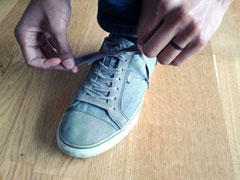
Source: Tying one’s shoe, asobuno, Wikimedia Commons
An example of an action and its inverse that you might experience in your everyday life is when you put on your shoes in the morning and then take them off at night. Untying your shoe is the inverse of tying your shoe.

Source: Tying one’s shoe, asobuno, Wikimedia Commons
Another example of an action and its inverse is the wrapping and unwrapping of a present.
![]() Click on the gift to see the function and the inverse of the function.
Click on the gift to see the function and the inverse of the function.
In this lesson, you will discover how to determine the inverse of a function given a table, an equation, a graph, or a mapping diagram. Before beginning, you will need to know a few definitions.
An function that consists of all ordered pairs (x, y) has an inverse that is the set of all ordered pairs (y, x). Another way to think of this is that the inverse of a function is undoing the function. The domain of the function becomes the range of its inverse, and the range of the function becomes the domain of its inverse. Using function notation, the original function is written as f(x) and its inverse, if it is also a function, it is written as f -1(x).
You are first going to explore the inverse of functions represented in tables and equations.